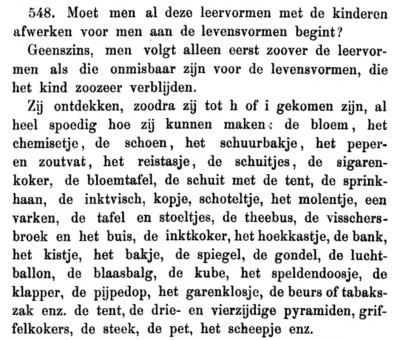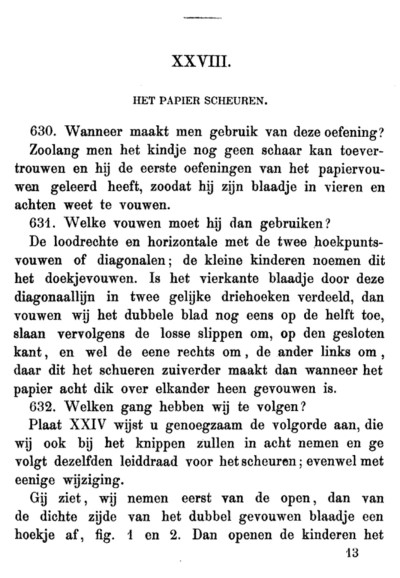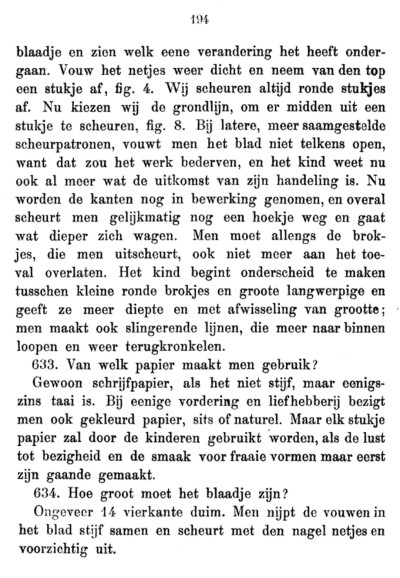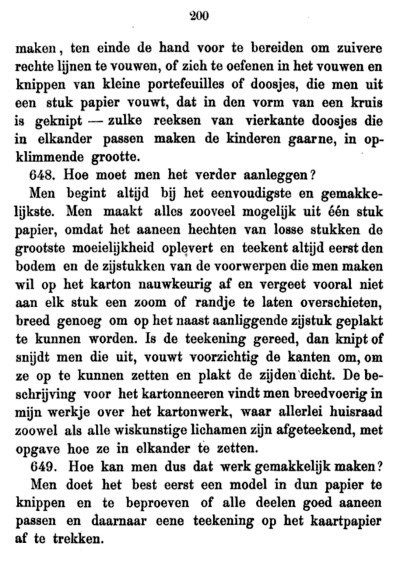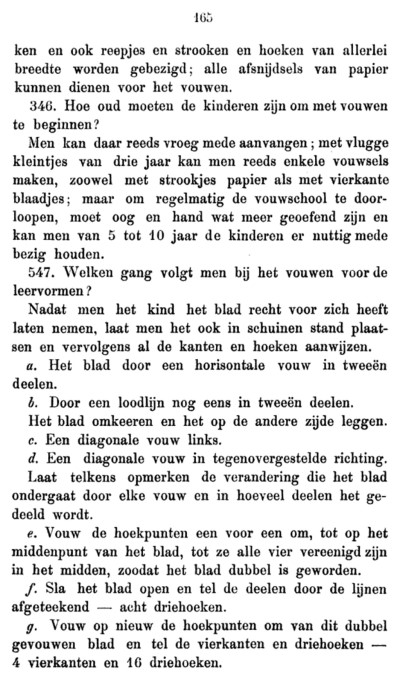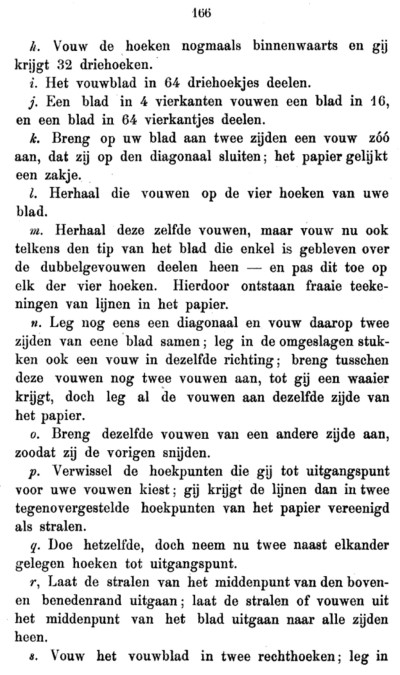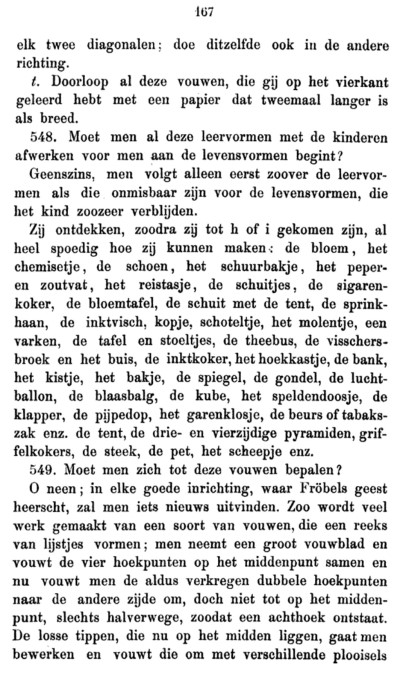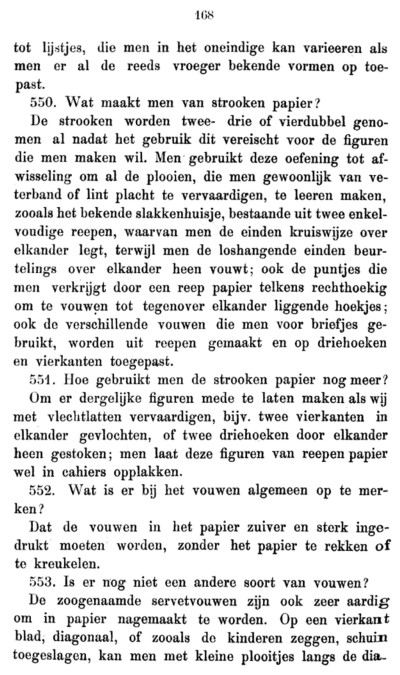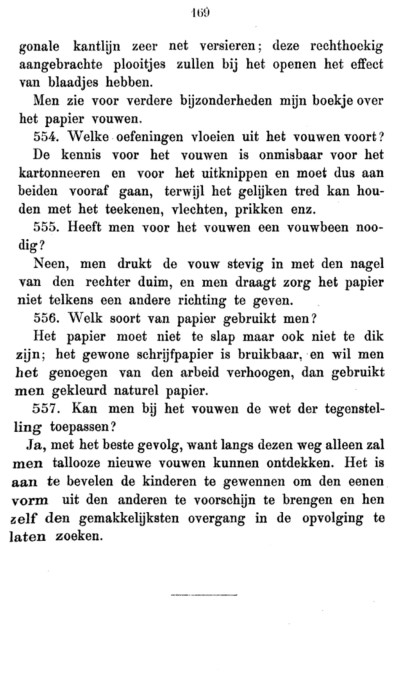| The Public Paperfolding History Project
Last updated 11/11/2025 x |
|||||||
| Maakt de Kinderen Gelukkig by Elise Van Calcar, 1880 | |||||||
'Maakt de Kinderen Gelukkig' by Elise Van Calcar was published by H C Van Calcar in Gravenhage in 1880. The work is in a question and answer format, which means that the information it contains is often not arranged in a very logical way. It contains brief sections about / mentions of Erkenntisformen (Folds of Knowledge), Lebensformen (Folds of Life), Napkin Folds, Schonnheitsformen (Folds of Beauty), Braiding, Verschnuren, Ausschneiden und Aufkleben (as Het Papier Scheuren ie paper tearing) and Cardboard Modelling. A full copy of the first edition of the work can be accessed online here. Unfortunately Plate XVIV is incomplete in this record. The Plate shown on this page has been taken from the 1893 second edition which can be found online here. I believe this plate was most probably identical in both editions. **********
********** Analysis Het Vouwen - Falten A full copy of this section can be found at the foot of the page. In her introduction to this section the author says, roughly: 'We take packs of paper of 50 or 100 sheets, cut into squares, but also other shapes, such as triangles, hexagons, octagons, and also strips ... of all widths are used; any cuttings of paper can be used for folding.'
********** Erkenntnisformen The author gives examples of geometric forms folded from the square that can be used to teach the child some basic mathematical ideas and then says: 'Go through all the folds you have learned on the square with a paper that is twice as long as it is wide.'
********** Levensvormen - Lebensformen This section provides a list of, but no other details about, 40 Lebensformen or Folds of Life. Many, though not all, can be identified with some certainty because they appear in the same order as the designs illustrated in the author's earlier book 'De Kleine Papierwerkers': de bloem (the flower) - probably The Flat Flower het chemisetje (the chemise) - probably The Collar de schoen (the shoe) - probably The Socks het schuurbakje (the sandbox) - probably The Sandbox het peper en houtvat (the salt and pepper shakers) - probably The Salt Cellar and the Pepper Pot het reistasje (the travel bag) - probably The Travel Bag de schuitjes (the boats) - probably The Double Boat de sigarenkoker (the cigar case) - probably The Cigar Case de bloemtafel (the flower table) - probably The Vase de schuit mit de tent (the boat with the tent) - probably The Boat with Sail de sprinkhaan (the grasshopper) - probably The Cocotte / Pajarita de inktvisch (the squid) - probably The Squid kopje (cup) / schoteltje (saucer) - probably The Cup and Saucer het molentje (the mill) - probably The Windmill de theebus (the tea caddy) - probably The Inkwell de visschersbroek en het buis (the fishing trousers and the tube) - probably The Trousers and possibly also The Jacket de inktoter (the inkwell) - probably The Steamship het hoekkastje (the corner cupboard) - probably The Corner Cupboard de bank (the bench) - probably The Bench het kistje (the casket) - probably The Sulphur Box het bakje (the box) - probably The Junk Box de spiegel (the mirror) - probably The Looking Glass de gondel (the gondola) - probably The Chinese Junk de luchtballon (the hot air balloon) - probably The Hot Air Balloon de blaasbalg (the bellows) - probably The Bellows de kube (the cube) - probably The Waterbomb de klapper (the banger) - probably The Banger de pijpedop (the pipecap) - probably The Pipecap het garenklosje (the thread spool) - probably The Yarn Spool de beurs of tabakszak enz (the tobacco pouch) - probably The Tobacco Pouch ********** The following designs do not appear in 'De Kleine Papierwerkers' and are therefore unidentifiable or identifiable with less certainty: een varken (a pig) - probably The Pig de tafel en stoeltjes (the table and chairs) het speldendoosje (the pinbox) de tent (the tent) de drie- en vierzjdige pyramiden (three and four-sided pyramids) griffelkokers (pencilcases) de steek (the stitch) de pet (the cap het scheepje (the ship) **********
********** Servetvouwen - Napkin Folds Roughly translated this section reads: 'The so-called servetvouwen (napkin folds) are also very nice to recreate in paper. On a square sheet of paper, folded diagonally ... you can make small pleats ... which will have the effect of leaves when opened.' and adds 'For further details see my booklet on paperfolding.'
********** Schonnheitsformen This section describes a type of octagonal Schonnheitsformen, roughly translated: 'a type of folding that forms a series of frames; one takes a large piece of paper and folds the four corners together at the centre point, and then folds the resulting double corners over to the other side, but not all the way to the centre point, only halfway, thus creating an octagon. The loose ends, which now lie on the centre, are worked on and folded over with various pleats ...'.
********** Braiding The section refers to braiding designs from two, three or four strips of paper 'to learn all the folds commonly made with lace or ribbon' and specifically: het bekende slakkenhuisje (the well known snail house) - which I take, from the description, to be The Witch's Ladder The final sentence reads, roughly translated: 'the various folds used for notes are made from strips and applied to triangles and squares' which may be a reference to The Love-Knot Letterfold.
********** Verschnuren
********** Het Papier Scheuren (Paper Tearing) - Ausschneiden und Aufkleben This section explains the occupation of Ausschneiden and Aufklaben but for children who can't yet be trusted with scissors so that the folded paper is torn rather than cut.
********** Kartoneeren - Cardboard Modelling This occupation is intended for children of 7 years and older. Use of scissors is superseded by use of a knife. Inter alia the author says, roughly translated: 'you can even use cards (presumably playing cards)to learn the basics, as they can be handled with scissors and it doesn't matter if you make mistakes. It's even recommended to have the children build houses of cards from regular playing cards first to prepare the hand to fold clean, straight lines, or to practice folding and cutting out small wallets or boxes, which one folds from a piece of paper cut into the shape of a cross. Children like to make a series of square boxes that fit inside each other in increasing size.' and 'Always first carefully draw the base and sides of the object one wishes to make on the cardboard, remembering to leave a seam or edge on each piece wide enough to be glued to the adjacent side piece.'
********** Selected Pages
********** |
|||||||




